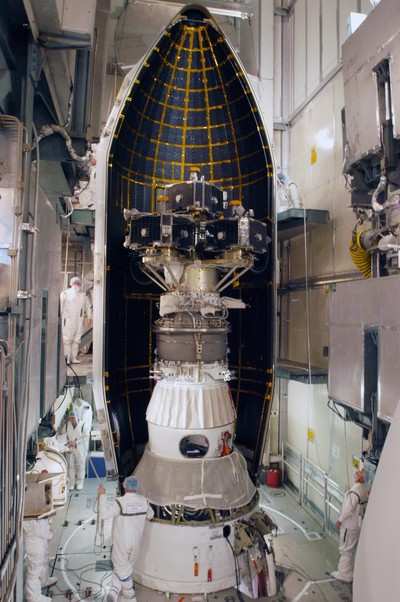Satellites Have Completed Original Missions, On To New
Tasks
 Two NASA spacecraft have been assigned a new mission after
successfully completing their original science objectives earlier
this year. The duo began making observations this week to study how
solar wind electrifies, alters and erodes the moon's surface. Data
could reveal valuable information for future explorers and give
planetary scientists a hint of what's happening on other worlds
around the solar system.
Two NASA spacecraft have been assigned a new mission after
successfully completing their original science objectives earlier
this year. The duo began making observations this week to study how
solar wind electrifies, alters and erodes the moon's surface. Data
could reveal valuable information for future explorers and give
planetary scientists a hint of what's happening on other worlds
around the solar system.
The new mission is called ARTEMIS, or Acceleration,
Reconnection, Turbulence and Electrodynamics of Moon's Interaction
with the Sun. ARTEMIS uses two of five in-orbit spacecraft from
NASA's THEMIS, or Time History of Events and Macroscale
Interactions during Substorms, mission.
"Using two repurposed satellites for the ARTEMIS mission
highlights NASA's efficient use of the nation's space assets," said
Dick Fisher, director of the Heliophysics Division in NASA's
Science Mission Directorate at the agency's headquarters in
Washington.
ARTEMIS will measure solar wind turbulence on scales never
sampled by previous missions. Solar wind is a stream of charged
particles emitted from the upper atmosphere of the sun.
"ARTEMIS will provide a unique two-point view of the moon's
under-explored space environment," said Vassilis Angelopoulos of
the University of California in Los Angeles (UCLA), principal
investigator of the THEMIS mission. "These two spacecraft are
headed for an incredible new adventure."
One ARTEMIS spacecraft reached what is called the L2 Lagrange
point on the far side of the moon on Aug. 25. On Oct. 22, the other
spacecraft entered the L1 Lagrange point on the Earth-side of the
moon. Lagrange points are places where the gravity of Earth and
moon balance, creating a sort of gravitational parking spot for
spacecraft. NASA repositioned the two outermost THEMIS spacecraft
using spare on-board fuel and a set of complex orbit maneuvers over
the course of more than a year.

THEMIS Probes
"ARTEMIS is going where no spacecraft have gone before," said
Manfred Bester, Mission Operations manager from the University of
California at Berkeley, where the spacecraft are operated. "We are
exploring the Earth-Moon Lagrange points for the first time."
After six months at the Lagrange points, ARTEMIS will move
closer to the moon. The spacecraft will be approximately 62 miles
from the surface at first, but will eventually move closer. From
point-blank range, the spacecraft will look to see how the solar
wind impacts a rocky world when there's no magnetic field to
protect it. Earth is protected from solar wind by its magnetic
field. However, the moon is exposed because it has no global
magnetism.
Launched in 2007, THEMIS was NASA's first five-satellite mission
launched aboard a single rocket. The unique constellation of
satellites provided scientists with data to help resolve the
mystery of how Earth's magnetosphere stores and releases energy
from the sun by triggering geomagnetic substorms. The three
remaining THEMIS satellites continue to study substorms that are
visible in the Northern Hemisphere as a sudden brightening of the
Northern Lights, or aurora borealis. The mission was one of NASA's
series of low-cost, rapidly developed missions in the Explorers
Program. ATK, formerly Swales Aerospace, in Beltsville, Md., built
the THEMIS probes. Goddard manages the program for the agency's
Science Mission Directorate.
 Aero-News: Quote of the Day (04.28.25)
Aero-News: Quote of the Day (04.28.25) ANN's Daily Aero-Term (04.28.25): Decision Altitude (DA)
ANN's Daily Aero-Term (04.28.25): Decision Altitude (DA) ANN's Daily Aero-Linx (04.28.25)
ANN's Daily Aero-Linx (04.28.25) Airborne-Flight Training 04.24.25: GA Refocused, Seminole/Epic, WestJet v TFWP
Airborne-Flight Training 04.24.25: GA Refocused, Seminole/Epic, WestJet v TFWP Aero-News: Quote of the Day (04.29.25)
Aero-News: Quote of the Day (04.29.25)




